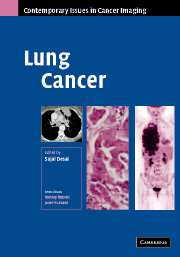Book contents
- Frontmatter
- Contents
- Contributors
- Series Foreword
- Introduction
- 1 Clinical Considerations in Lung Cancer
- 2 Pathology of Lung Cancer
- 3 Imaging of Lung Cancer
- 4 Screening for Lung Cancer
- 5 Staging of Lung Cancer
- 6 Positron Emmision Tomography in Lung Cancer
- 7 Contemporary Issues in the Systemic Treatment of Lung Cancer
- 8 Radiotherapy in Lung Cancer
- 9 Surgery for Lung Cancer
- Index
- Plate Section
- References
1 - Clinical Considerations in Lung Cancer
Published online by Cambridge University Press: 12 August 2009
- Frontmatter
- Contents
- Contributors
- Series Foreword
- Introduction
- 1 Clinical Considerations in Lung Cancer
- 2 Pathology of Lung Cancer
- 3 Imaging of Lung Cancer
- 4 Screening for Lung Cancer
- 5 Staging of Lung Cancer
- 6 Positron Emmision Tomography in Lung Cancer
- 7 Contemporary Issues in the Systemic Treatment of Lung Cancer
- 8 Radiotherapy in Lung Cancer
- 9 Surgery for Lung Cancer
- Index
- Plate Section
- References
Summary
Introduction
Lung cancer remains one of the commonest malignancies, accounting for 20% of all cancers in men with a lifetime risk of 1 in 13 and 12% of all cancers in women with a lifetime <risk of 1 in 23. In the United Kingdom roughly 40,000 new cases are recorded each year. The estimated incidence for lung cancer in males in 2005 in the United States was 92,305 with approximately 91,537 males expected to die from the disease. The risk of lung cancer is about fourfold greater in men than in women and this increases with age: in the European Union the incidence of lung cancer is 7 per 100,000 for men and 3 per 100,000 for women at the age of 35 years, but in patients aged over 75, the rates are 440 and 72 in men and women respectively. Wide geographical variations in the incidence of lung cancer are also reported and this is primarily related to worldwide variations in smoking behaviour.
Aetiology
Smoking cigarettes is far and away the dominant risk factor in patients with lung cancer, accounting for 90% of lung cancers in men and almost 80% of cases in women. The relationship between smoking and lung cancer mortality was first established by Doll and Hill. In their study, newly admitted patients with suspected lung, liver or bowel cancers were questioned.
- Type
- Chapter
- Information
- Lung Cancer , pp. 1 - 11Publisher: Cambridge University PressPrint publication year: 2006



